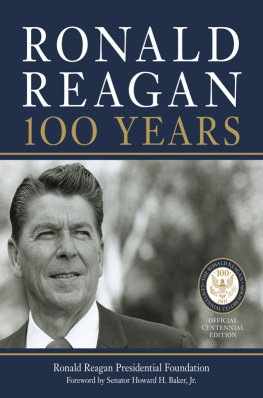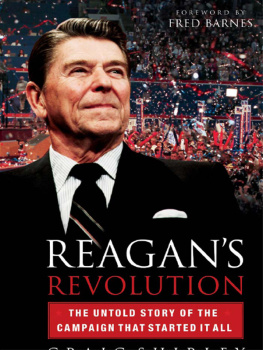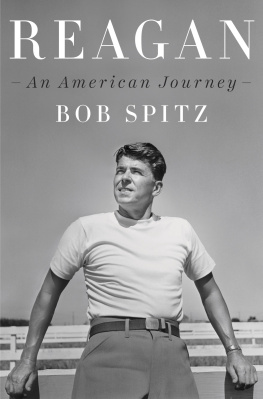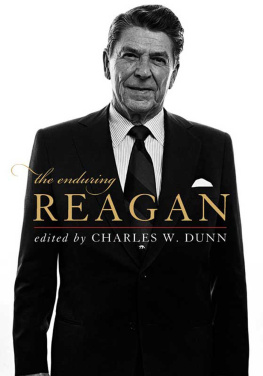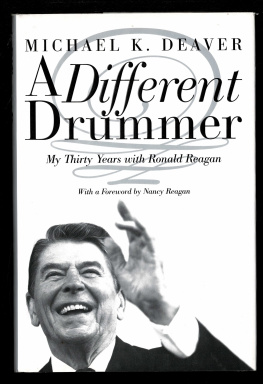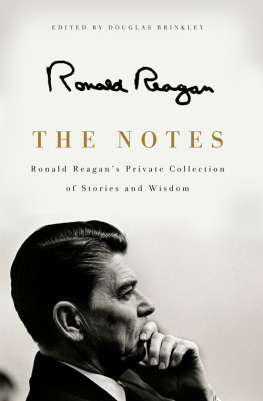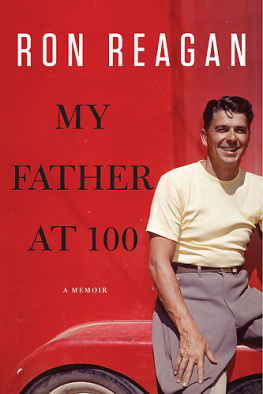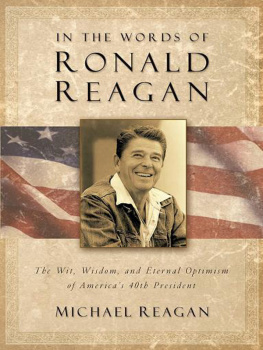Praise for Lou Cannons President Reagan
Lou Cannon has written a devastating account of Ronald Reagans Presidency.
The New York Times
Lou Cannons latest portrait of Ronald Reagan, his third, is the best study of that enigmatic Presidency yet available. The tone is judicious, the hyperbole limited and the coverage comprehensive.
The New York Times Book Review
Reagan was Lous property for thirty years. He followed him as a journalist all his life and he wrote an excellent biography of Reagan. From the reportorial point of view, if you want to know all the basic facts about Reagans life and presidency, you go to Lous book.
Edmund Morris, author of Dutch: A Memoir of Ronald Reagan
President Reagan is essential reading for anyone who wants to understand the star of politics in the 1980s.
Time
Heres the rest of himthe real Reagan, without the makeup or the handlers, seen through the eyes of the keenest Reagan-watcher of them all, Lou Cannon. All of Reagans friends and foes will find this book indispensable.
John Chancellor, NBC News
P RESIDENT R EAGAN
P RESIDENT R EAGAN
A LSO BY L OU C ANNON
Ronnie and Jesse: A Political Odyssey (1969)
The McCloskey Challenge (1972)
Reporting: An Inside View (1977)
Reagan (1982)
Official Negligence: How Rodney King and the Riots
Changed Los Angeles and the LAPD (1998)
Ronald Reagan: The Presidential Portfolio (2001)
Governor Reagan: His Rise to Power (2003)
PRESIDENT
REAGAN
THE ROLE of
A LIFETIME
L OU C ANNON

P UBLIC A FFAIRS
N EW Y ORK
Copyright 1991, 2000 by Lou Cannon.
With the exception of the photograph of the Reagans and the Gorbachevs at Rancho del Cielo,
which is credited to Steve Malone of the Santa Barbara News-Press, all other photos
are courtesy of the Ronald Reagan Library in Simi Valley, California.
Published in the United States by PublicAffairs, a member of the Perseus Books Group.
All rights reserved.
No part of this book may be reproduced in any manner whatsoever without written permission
except in the case of brief quotations embodied in critical articles and reviews.
For information, address PublicAffairs, 250 West 57th Street, Suite 1321, New York, NY 10107.
BOOK DESIGN BY JENNY DOSSIN.
Library of Congress Cataloging-in-Publication Data
Cannon, Lou.
President Reagan : the role of a lifetime / Lou Cannon.
p. cm.
Originally published: New York : Touchstone/Simon & Schuster, 1991.
Includes bibliographical references and index.
ISBN 1-891620916 (pbk)
1. Reagan, Ronald.
2. PresidentsUnited StatesBiography.
3. United StatesPolitics and government19811989.
I. Title.
E877.C35 2000
973.927'092dc21
[B]
99088017
First PublicAffairs Edition 2000
1 3 5 7 9 10 8 6 4 2
T O M ARY, WITH LOVE AND APPRECIATION
C ONTENTS
M Y FIRST ENCOUNTER with Ronald Reagan occurred late in the autumn of 1965 when he visited Sacramento during a trip around the state to drum up interest in his candidacy for governor. Reagan gave a short speech, answered a few questions from a curious audience and stayed afterward to chat with reporters, many of whom remembered him as the host of General Electric Theater or Death Valley Days. A former Democrat who had become a Republican, Reagan was then a supposedly washed-up actor who was in the process of changing careers. On October 27, 1964, he had stirred conservatives out of their socks with a rousing nationally televised speech in behalf of Republican presidential candidate Barry Goldwater. But Goldwater had been demolished by Lyndon Johnson in the election the following week, and Reagan in 1965 bore a Goldwater Republican label. The Democrats were so unimpressed by Reagan that many of them were rooting for him to win the Republican nomination, certain that he would be defeated by Democratic Governor Pat Brown.
Reagan made a good impression on his audience in Sacramento. He readily confessed that he knew little about government but suggested that his lack of experience would give him the advantage of taking a fresh look at Californias problems. He answered questions sensibly and without a hint of guile. He was as pleasant in response to skeptical questioners as he was to friendly ones. He fascinated me. What I noticed most was that everyone seemed to like him, the reporters included. When my editor at the San Jose Mercury-News asked me afterward what I thought of Reagan, I said that I couldnt understand why anyone would want to run against such a self-assured and friendly man. And I still dont fully understand why the Democrats regarded Reagan as such an easy mark. Subsequently, he defeated Brown by nearly a million votes, which was no small feat. Although he bore the scars of two-term incumbency, Pat Brown was a capable politician who had routed Richard Nixon in the gubernatorial race four years earlier. How had Reagan done it? And why was it, after his victory, that he so totally dominated the California political landscape? On one level he seemed the citizen-politician he claimed to be, almost completely ignorant of even civics-book information about how bills were passed or how an administration functioned. But on another level, he seemed the most consummate and effective politician I had ever met.
The late Carey McWilliams once told me that the essential motive of his booksand he wrote great books about California, farm workers, racial prejudice, anti-Semitism, and other issueswas to explain to himself phenomena that he did not fully understand. That was my original reason for writing about Reagan. My first book, Ronnie and Jesse: A Political Odyssey, published in 1969, was a dual biography of Reagan and the remarkable politician Jesse Unruh, who revolutionized the California state legislature and lost to Reagan in the gubernatorial election of 1970. A subsequent biography, Reagan, published in 1982, was an account of Reagans early years, his rise to the presidency and his first year in the White House.
This is the third and last book in what became an unintended trilogy on Ronald Reagan. Its focus is on his performance in the presidency. But since Reagan is among the most personal of our chief executives, it is impossible to make sense of his presidency without also examining his life. This I have tried to do, drawing upon scores of interviews with Reagan during the past quarter century, including three for this book, and hundreds of interviews with his former aides, advisers, friends, scholars, and critics. I have also relied upon my reporting for more than a thousand articles and columns written as senior White House correspondent for



